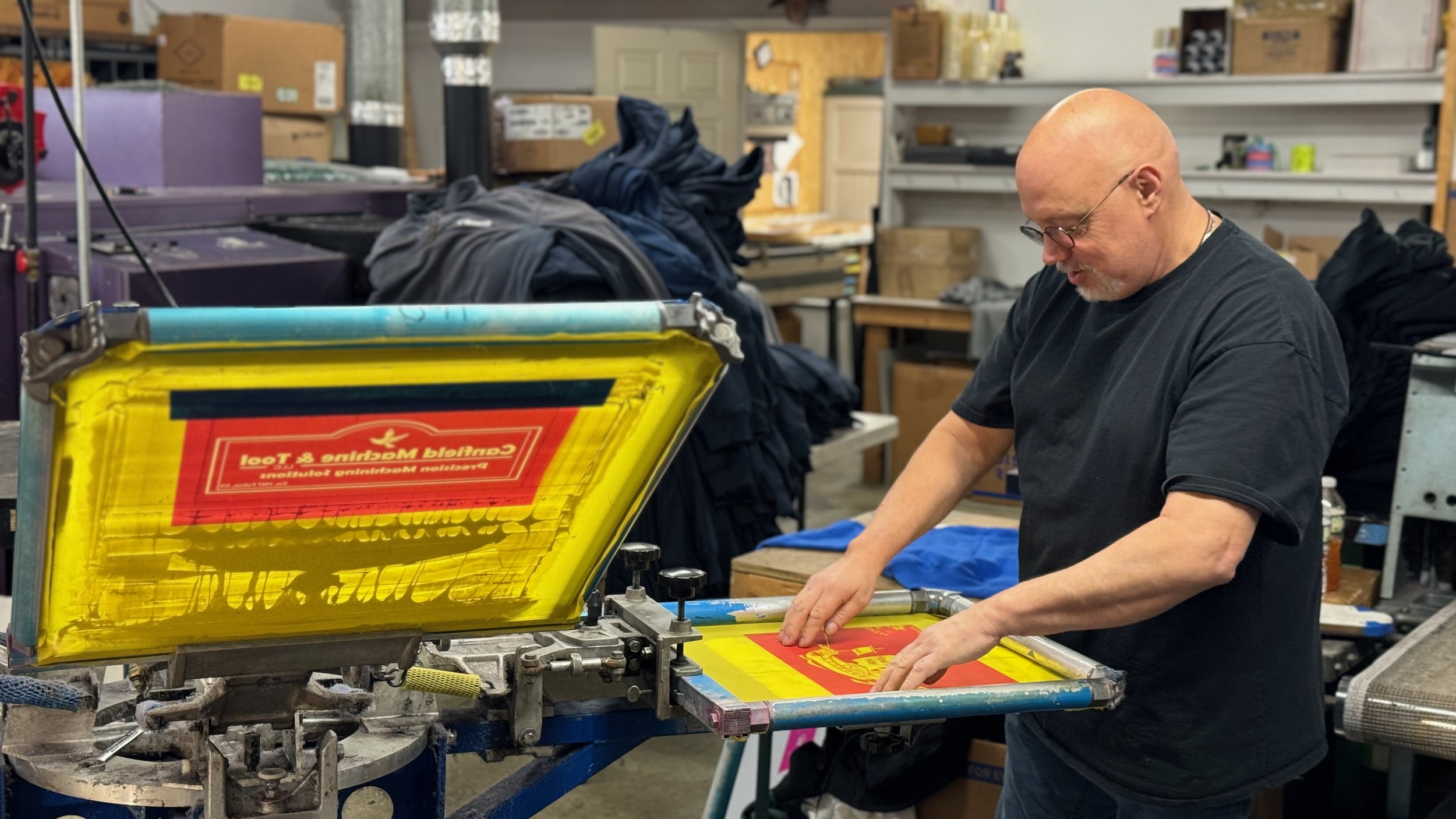Display Printing Uncovered: Everything You Need to Find Out About T-Shirt and Garment Printing Methods
Screen printing is a remarkable approach that combines art with method, providing countless opportunities for imagination. All set to check out the vital aspects that make screen printing an art form?
The Essentials of Screen Printing: How It Works
When you plunge right into screen printing, you'll discover it's both a science and an art. At its core, display printing involves developing a pattern, or display, that allows ink to pass via just in specific areas (screen printing kit). You start by picking your style and preparing your display with a light-sensitive solution. As soon as you subject this emulsion to light, it solidifies, leaving your design as a negative room.
Next, you'll mix your inks and prepare your printing surface area. Setting the screen over the fabric, then make use of a squeegee to push ink with the screen onto the garment. This procedure needs accuracy, as you want clear, vivid prints. After printing, you'll treat the ink with heat, ensuring it sticks to the material and lasts through laundries. Each action is crucial, and grasping them will raise your screen printing skills, transforming basic garments into special, meaningful pieces.
Kinds of Screen Printing Strategies
Once you understand the basics of display printing, it's time to discover the different methods that can boost your designs. One popular method is typical screen printing, where ink is pushed with a stenciled display. This strategy is fantastic for bold, dynamic colors. After that there's water-based ink printing, which uses a softer feel and is eco-friendly, however it needs a different method to treating.
If you're going for fine details, consider discharge printing. This strategy eliminates color from the textile, leaving a soft, classic look. Another option is plastisol printing, understood for its longevity and dazzling colors, making it a preferred for lots of brands. Finally, trying out halftone printing to produce slope impacts and elaborate layouts. Each technique has its unique charm, so do not hesitate to attempt them bent on locate what fits your style best!
Necessary Tools for Display Printing
To attain magnificent results in display printing, having the right devices is fundamental. You'll need a tough screen printing frame, which holds the mesh that moves your style onto the garment. Next off, spend in high-quality mops; these are crucial for applying ink uniformly across the screen.
Choosing the Right Inks and Products
When choosing inks and products for screen printing, you need to think about the sort of ink that functions ideal for your job. Believe concerning fabric compatibility to guarantee your layouts look wonderful and last lengthy. Discover green ink options to make your printing process extra lasting.
Kinds Of Display Inks
Selecting the appropriate screen ink is vital for attaining vibrant, long lasting prints that fulfill your job's needs. There are several kinds of display inks to check out. Plastisol ink is popular for its adaptability and ease of use, offering superb shade opacity on dark materials. Water-based ink, on the other hand, supplies a softer feel and is environment-friendly, making it excellent for those wanting to decrease their environmental effect. Release inks eliminate color from the material, leading to a soft, classic look however call for details handling. Ultimately, specialized inks, such as metal or glow-in-the-dark, can include special results to your styles. Evaluate your job demands and pick the ink that aligns ideal with your wanted end result.

Material Compatibility Considerations
Understanding textile compatibility is important for achieving high-quality screen prints, particularly given that different products respond uniquely to different inks. When choosing inks, think about the material kind-- cotton, polyester, or blends. For cotton, water-based inks function well, offering softness and breathability. Polyester, on the various other hand, often requires plastisol inks for far better bond and vivid shades. You could need to make use of a mix of both types if you're publishing on blends. Constantly test your inks on sample fabric to guarantee they stick appropriately and maintain color honesty. Additionally, bear in mind that material weight and appearance can impact the final end result, so choosing the ideal ink and material combination is important for your job's success.
Eco-Friendly Ink Options
Environmentally friendly inks are becoming a prominent option for screen printers who want to lessen their ecological impact while keeping top quality. When choosing inks, think about water-based inks, which are much less unsafe and much easier to clean up contrasted to conventional solvents.
Additionally, seek inks made from renewable energies, such as soy or vegetable-based choices. By picking the ideal inks and products, you'll not only produce spectacular designs yet additionally add to a much more sustainable printing process. Make the switch, and your prints will certainly show your commitment to the atmosphere!
Preparing Your Style for Screen Printing

Submit Format Demands
To assure your layout looks sharp and dynamic on textile, you'll need to you can try here pay close attention to submit format requirements for screen printing. Make certain your layout has a clear background to stop unwanted white sides on your prints. Maintain shade modes in mind; CMYK is typical for display printing, so convert your RGB develops appropriately.
Color Separation Techniques
Color separation is a necessary action in preparing your style for screen printing, and grasping it can substantially boost your print top quality. You'll require to damage your style right into private shades, as each shade requires a different screen during printing. Begin by determining all the colors in your design and develop layers for each one. You can utilize software application like Adobe Photoshop or Illustrator to isolate and separate shades effectively. Be particular to conserve each layer as a separate file, typically in a format like TIFF or PSD. This accuracy not only guarantees precise color representation yet likewise improves the printing procedure. By taking note of color splitting up, you'll accomplish professional and dynamic results in your screen-printed garments.
Resolution and Dimension
Accomplishing the very best cause display printing begins with ensuring your layout has the best resolution and dimension. Ideally, your artwork ought to be at least 300 DPI (dots per inch) for sharp, clear prints. If you make use of lower resolution, your end product might look less than professional and pixelated.
When it involves dimension, take into consideration the dimensions of your print location. Layout your art work to match the last print size, preferably browse around this web-site developing it in the real dimensions you'll be printing. This way, you'll stay clear of any unforeseen scaling problems.
Constantly inspect your design in both vector and raster formats. Vector graphics can be scaled without losing high quality, making them excellent for screen printing. Preparing correctly will ensure your style looks incredible on every garment!
Step-by-Step Screen Printing Process
Display printing is a dynamic process that enables you to produce dynamic designs on numerous surface areas. To get started, you'll need a display, solution, and your chosen ink.
After rinsing the unexposed solution, your display prepares. Set it up on your printing surface area and straighten your garment underneath it. Pour ink onto the screen and make use of a squeegee to press the ink through the stencil onto the material. Raise the display carefully and allow the print completely dry. Treat the ink using warmth to guarantee resilience. That's it! You have actually efficiently screen published your design.
Tips for Successful Screen Printing Projects
While you're diving right into your screen printing tasks, bear in mind that preparation is key to success. Beginning by gathering all your products-- inks, displays, squeegees, and garments. A tidy work space assists prevent undesirable mistakes, so clean up prior to you begin.
Next, validate your artwork is high-resolution and properly sized for your garment. Check your screen for appropriate direct exposure and clean it extensively to stay clear of smudges. When blending your inks, follow the producer's standards to attain the ideal uniformity.
During printing, use also pressure with your squeegee for consistent outcomes. Do not rush; take your time to confirm each print fulfills your criteria. After printing, let your garments completely dry completely before taking care of or packaging them.
Finally, always keep an example of your help future referral. This method, you can analyze your development and enhance your strategies with time. Pleased printing!

Often Asked Concerns
Exactly how Long Does It Take to Establish a Display Printing Work?
Establishing up a display printing task normally takes about 30 minutes to an hour. You'll prepare the displays, mix inks, and readjust journalism. The time varies based upon intricacy and experience, so stay organized!
Can I Publish on Various Fabric Types Making Use Of the Exact Same Method?
Yes, you can print on various material types making use of the very same method, however you'll need to readjust your settings and inks. Some textiles take Learn More Here in ink in a different way, so experimenting warranties the very best outcomes for each product.
What Are Typical Mistakes to Stay Clear Of in Display Printing?
When display printing, avoid usual errors like using the incorrect ink, disregarding correct direct exposure times, or missing pre-press checks. Always check your configuration and maintain tidy screens to assure top quality results each time.
Just How Can I Correctly Tidy and Maintain My Display Printing Devices?
To properly clean and keep your screen printing equipment, you should regularly clean displays with appropriate solvents, check mops for wear, and ensure all devices are kept dust-free and dry. Consistency enhances and stops pricey repair work efficiency.
Is Screen Printing Eco-friendly Compared to Other Approaches?
Screen printing can be a lot more eco friendly than other techniques, specifically if you use water-based inks and eco-conscious products. By picking sustainable materials and methods, you reduce waste and decrease your influence on the planet.
Screen Printing Uncovered: Everything You Required to Know Regarding T-Shirt and Garment Printing Techniques
At its core, screen printing includes developing a pattern, or display, that allows ink to pass through only in particular areas. Setting the display over the textile, after that make use of a squeegee to press ink via the screen onto the garment. One prominent approach is typical display printing, where ink is pressed via a stenciled display.When picking inks and products for display printing, you require to take right into account the kind of ink that functions best for your project.